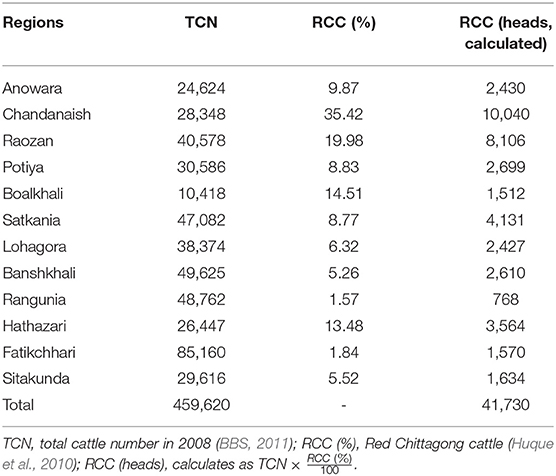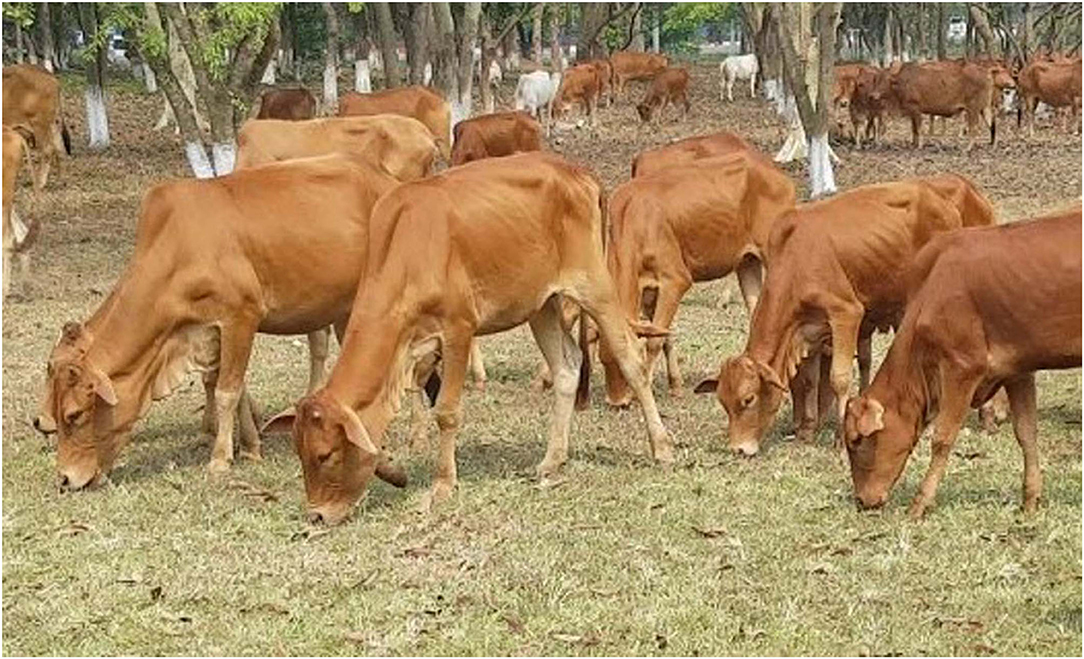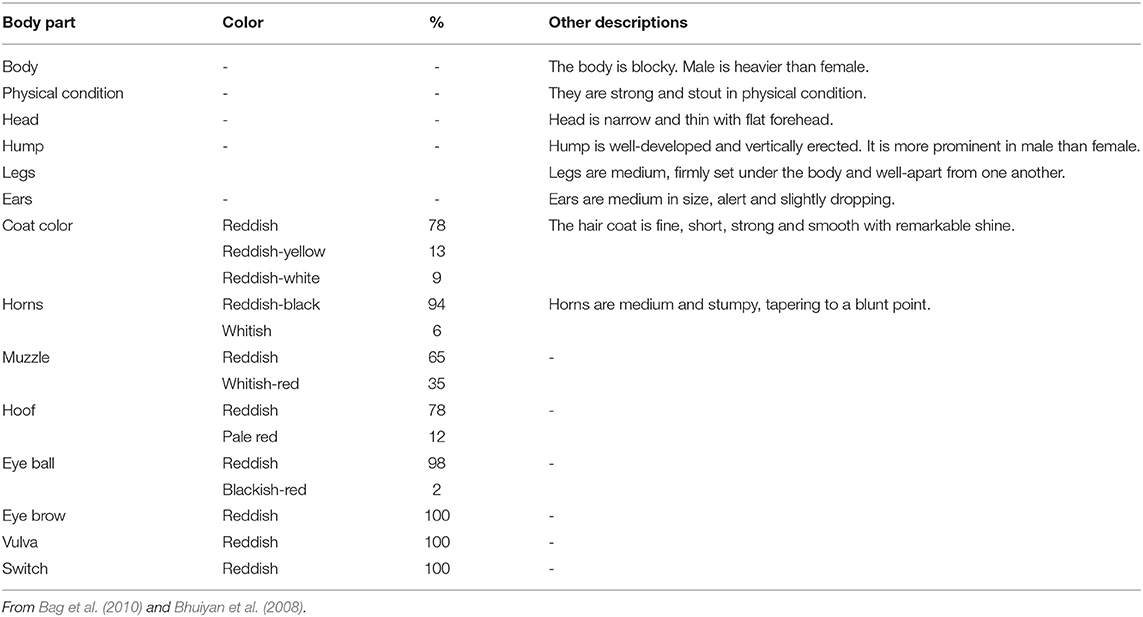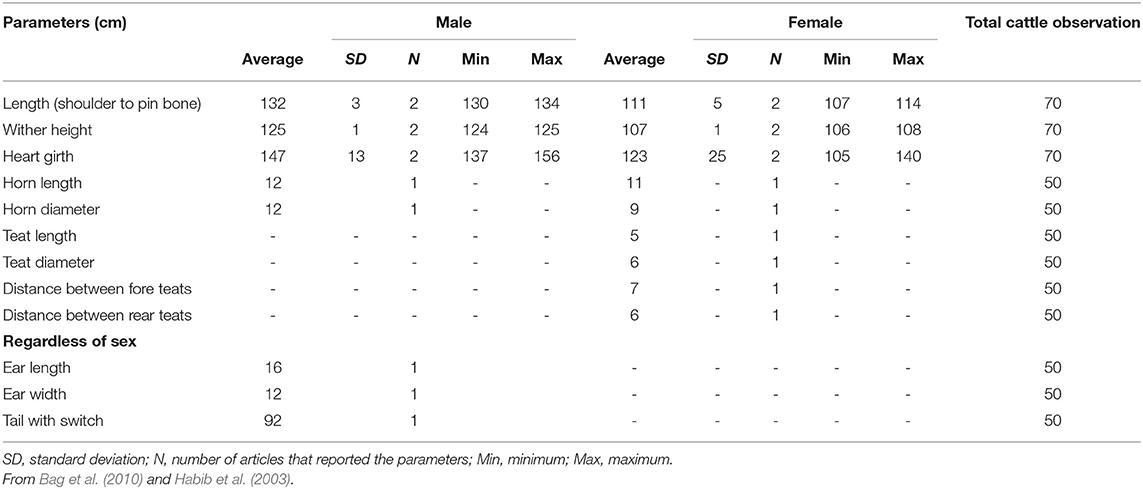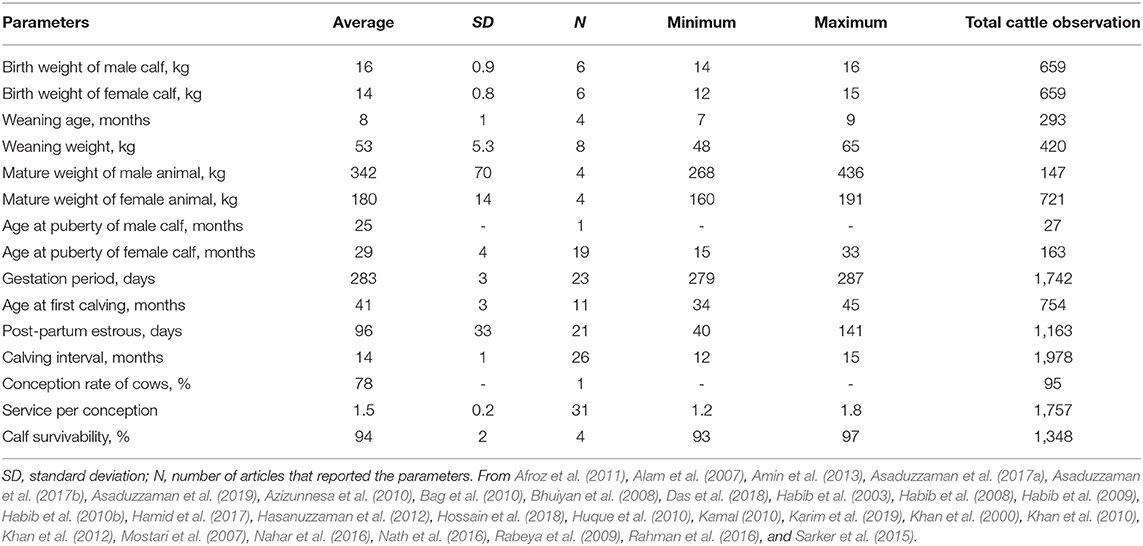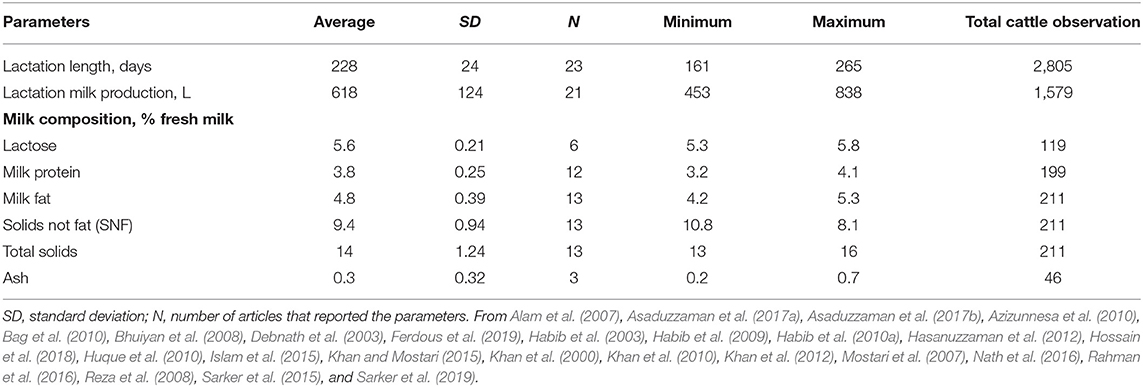- 1Animal Production Research Division, Bangladesh Livestock Research Institute, Dhaka, Bangladesh
- 2Livestock Production and Welfare Group, School of Life and Environmental Sciences, University of Sydney, Sydney, NSW, Australia
Modern livestock selection is rapidly condensing the indigenous cattle gene pool. This trend limits the options for future genetic selection to benefit both animal well-being and farmer challenges. Here we reveal the potential of Red Chittagong cattle (RCC), a native genotype of Bangladesh, for tackling these current and pending challenges. Red Chittagong cattle are reddish in color and small in size with mature bulls and cows weighing 342 and 180 kg from birth weights of 16 and 14 kg, respectively. Whilst low mean levels of milk production of 618 L across a 228-day lactation are recorded so are high levels of milk protein (3.8%) and fat (4.8%) with offered feed types typically low in nutritive value, particularly crude protein. However, one in five cows under farm condition yield >1,000 L/lactation. Alongside high levels of milk protein and fat, other key features of this breed include resistance to common diseases and parasites with a high level of adaptation to agro-ecological conditions. As opposed to other indigenous breeds, there is currently high genetic variation in the RCC population, and associated variation in productive and reproductive traits highlighting the opportunity for development through long-term breeding programs alongside improved management conditions. Such efforts would enable this breed to become a global resource for tackling the challenges of modern animal production systems. In addition, further work is required to reveal the demographic distribution of the breed, potential production levels through the provision of improved diets and the mechanisms enabling disease resistance and digestibility of feeds.
Introduction
The transition of agriculture from the Neolithic age to the intensive commercial systems of today helps ensure food security and better standards of living for the growing global population (Silbergeld, 2019). In many commercial animal production systems around the world, high producing animals of similar genotypes are typically reared in confined housing systems with mechanically processed feedstuff. Recently, farms in Bangladesh have introduced Holstein genetics into more intensive systems from Australia and the Netherlands. Such high producing animal genotypes are reared to achieve high productivity and profitability, largely omitting native animal genotypes which threatens their survival as a breed. Moreover, such intensification may increase the risk of disease transmission both between animals, and animal-to-human, alongside antibiotic resistance (Leibler et al., 2017; Aidara-Kane et al., 2018). Therefore, long term sustainability of intensive livestock production using commercial breeds, which mostly developed in the temperate countries, is questionable especially under tropical climatic condition. In contrast, native livestock resources in tropical countries evolved through natural selection based on the phenotype characteristics and organoleptic evaluation (tastes of products) preferred by the native consumers whilst these local breeds are typically adapted to prevailing hot and humid climates, locally available feeds, are resistant to parasitic and diseases, and have a greater survival rate, giving birth to a calf every year (i.e., more fertile). For example, Khan et al. (2012) reported the profitability of rearing crossbred dairy cows in Bangladesh (Holstein × Indigenous cattle) was less than native Red Chittagong Cattle (RCC) on a lifetime productive performance basis. Also, indigenous cattle genetic resources are usually resistant to some parasites, disease infections and environmental stress in their natural habitats (Nyamushamba et al., 2017). Therefore, maintaining an improved balance between intensification of commercial genotypes (mainly Holstein and their crossbreds/hybrids that are frequently reared in commercial farms) and the extension of high producing local genotypes may help ensure food and nutrition security and improve health of local communities by keeping antibiotic resistance of animals and reducing community disease transmission into the future. In this context, this review will focus on the native Red Chittagong cattle (RCC) breed of Bangladesh—a breed developed under highly challenging environmental conditions.
The name “Red Chittagong” cattle is derived from the breed's reddish coat color (Huque et al., 2010; Bhuiyan, 2013; Sultana, 2018) and the name of its natural breeding habitat—Chittagong, Bangladesh. Red Chittagong cattle are regarded as an improved native cattle species in Bangladesh (Mason and Buvanendran, 1982; Mason, 1988). Other improved native cattle genotypes found in Bangladesh are Pabna cattle at Pabna region, North Bengal Gray at Northern region, and Munshigonj and Madaripur cattle of Central Bangladesh (BLRI, 2004; Bhuiyan et al., 2005; Hossain, 2005; Bhuiyan, 2013; Sultana, 2018). Red Chittagong cattle are a dual-purpose breed for dairy and beef production and play a key role in poverty alleviation for small holder farmers in its habitat (BLRI, 2004). The breed also has a short post-partum heat period, high conception rates, greater milk fat content (Halim et al., 2010; Bhuiyan, 2013) and high calving rate (Khan et al., 2012). In addition, the breed is more resistant to parasites and diseases prevailing in its habitats than other cattle (Ahmed et al., 2015; Chowdhury et al., 2017) with high survivability in both adults and calves (Quaderi et al., 2013). A life-time economic evaluation of different dairy cattle breeds conducted in the rural areas of Chittagong reported greater profitability of rearing RCC compared to other cattle genotypes (Khan et al., 2012). Considering these attributes, RCC may be regarded as a potential cattle genotype to tackle the future challenges of intensive animal production in Bangladesh. Therefore, the objectives of this review were to synthesize existing research knowledge of the RCC breed and reveal the potential of this breed to tackle the challenges of our modern animal production systems whilst highlighting the opportunities for future research. A review of Red Chittagong cattle distribution, genotype and the interaction of this genotype with the environment (phenotype) are provided here.
The Distribution of Red Chittagong Cattle
The main habitat of RCC is in Chittagong. A survey conducted a decade ago (2008) in Chittagong found only 9% cattle were RCC ranging from 2% in the Rangunia region to 35% in Chandanaish (Table 1 and Figure 1) (Huque et al., 2010). Anecdotally, the number of RCC was decreasing due to indiscriminate crossbreeding with Holstein and other native cattle, presumably because of a common conception that crossbreds of native cattle with high-yielding breeds will produce more meat and milk, ignoring potentiality of lifetime productivity and profitability from RCC. Given these dwindling numbers, the Bangladesh Government took the initiative to protect this RCC in its habitat and develop the breed to help ensure its survival (RCC breed Improvement and Conservation Project, implemented by Bangladesh Livestock Research Institute during 2007–2012).
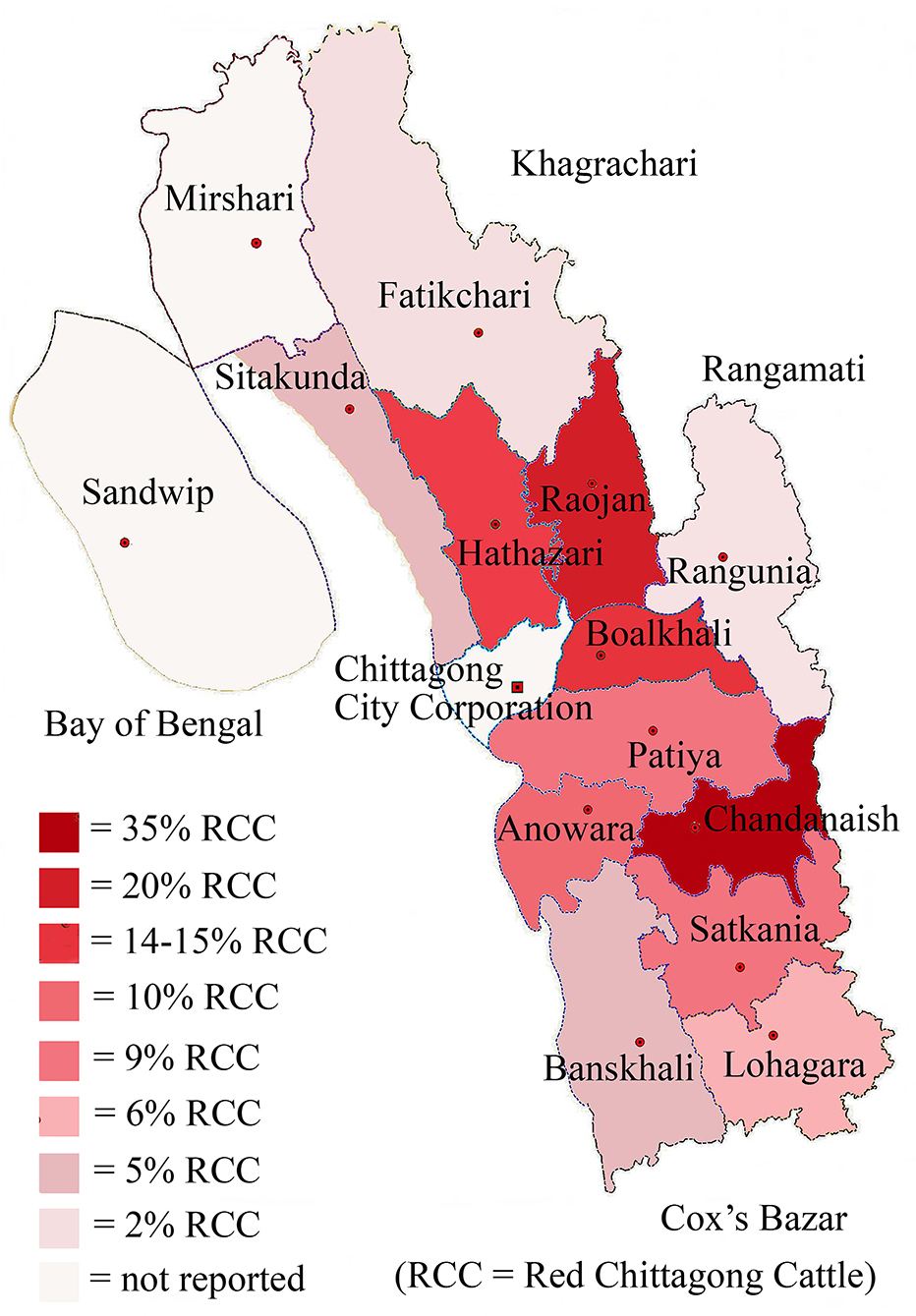
Figure 1. Geographical distribution of Red Chittagong cattle at Chittagong in 2008 [adapted from Huque et al. (2010)].
The impact of this government intervention is evident as per a recent survey (BSR, 2018) taken from six administrative regions of Chittagong (Anowara, Banskhali, Chandanaish, Hathazari, Patiya, and Satkania) that showed 15% of the total cattle population to be RCC. More importantly, this survey showed RCC was spreading throughout the country in the districts neighboring Chittagong such as Feni, Noakhali, Comilla, Rangamati, Bandarban, Khagrachori to as north as Mymensingh and Kurigram (Huque et al., 2010; Hamid et al., 2017; BSR, 2018). BSR (2018) in a recent survey reported 58% of cattle in Mymensingh sadar, 7% in Kurigram (Rajarhat) and 4% cattle in Bandarban (Naikhongchari) were RCC. Thus, a detailed survey is required to document RCC number and distribution across the country, including its impact on farmers to further steps to protect RCC and improve the breed through the genetic selection process.
Genotype
The origin of the RCC breed is closely linked to Indian zebu cattle genotypes (Bos indicus sub species). Bhuiyan et al. (2007a) reported that the mitochondrial DNA diversity between RCC and some zebu cattle (Ongole, Sahiwal, Hariana) was lower than the diversity between RCC and some taurine breeds (Friesian and Simmental). The minimum mitochondrial-DNA nucleotide sequence divergence value between RCC and Indian zebu cattle (Sahiwal, Hariana, and Ongole cattle; 0.011, 0.012, and 0.013, respectively) compared to some taurine cattle (Friesian, Hanwoo, and Simmental; 0.054, 0.055, and 0.056, respectively) indicates a close genetic relationship between RCC and Indian zebu cattle (Bhuiyan et al., 2007a), particularly between RCC and Sahiwal. When mitochondrial-DNA nucleotide sequence divergence value was viewed across time between RCC vs. Sahiwal, Hariana, and Ongole cattle, the estimated divergence time were ~22,700, 24,800, and 26,900 years before present (Bhuiyan et al., 2007a), suggesting their concurrent emergence long before the time of animal domestication (about 10,000 years). The Y-chromosome specific marker test (INRA-124) also showed no introgression of taurine blood in the RCC male (Bhuiyan et al., 2007a).
Whilst natural selection played a key role in the evolution of RCC, human activity also contributed to shaping the breed such as reddish coat color and strong and stout physical conformation suitable for draft and transport (Bhuiyan et al., 2008; Bag et al., 2010). These characteristics were also in line with the needs of rural farmers and their religious and social rituals, as a mature healthy bull with attractive red color is important for sacrifice during different religious events (such as, Eid al-Adha).
Bhuiyan et al. (2007a) reported a high genetic variation of this breed within the population using mitochondrial DNA sequence analysis. It also possesses moderate heritability of its productive traits, ranging from 0.38 to 0.49 (Table 2; Alam et al., 2007; Rabeya et al., 2009; Afroz et al., 2011, 2012; Rahman et al., 2016; Ferdous et al., 2019). The moderate heritability of traits imply that additive gene action may play a role in regulating them, and their improvement may be possible by improved management and selection practices. Bhuiyan et al. (2007b) also reported selective breeding programs as a key tool for the development of RCC.
Phenotype
The phenotypic traits of RCC shown (Figure 2) are taken from Bag et al. (2010) and Bhuiyan et al. (2008) and are presented in Table 3. The measurements of mature male and female Red Chittagong cattle body parts are provided in Table 4 and were taken from Bag et al. (2010) and Habib et al. (2003). The RCC is a readily distinguishable reddish indigenous cattle genotype with greater average body length, height at wither and heart girth (111–132, 107–125, and 123–147 cm, respectively; Table 5) than non-descriptive indigenous and North Bengal gray cattle (106, 100, and 129 and 100–105, 93–94, and 122–127 cm, respectively; Hamid et al., 2017), but much lower than Pabna cattle (164, 118, and 148 cm, respectively; Hamid et al., 2017). Therefore, RCC may be regarded as a medium-size breed amongst native Bangladeshi genotype, but a small genotype compared to crossbreds or temperate breeds.
Genotype Environment Interaction
Production and Reproduction
The productive and reproductive characteristics of the RCC breed are provided in Table 5. Overall, the birth weight of the RCC calf was between 14 and 16 kg (Table 5) similar to non-descriptive indigenous, but lower than Pabna, and North Bengal gray cattle (15, 21, and 18 kg, respectively; Bhuiyan, 2013). RCC heifers reached puberty 5, 9, and 7 months earlier than Munshiganj, Pabna, and Sahiwal cattle genotype in Bangladesh (34, 38, and 36 months, respectively; Bhuiyan, 2013). The gestation period of RCC (283 ± 3 days) was similar to other cattle genotypes in Bangladesh and the post-partum estrus of the RCC cow (96 ± 33 days) was lower than Sahiwal and Sindhi crossbreeds (105 and 127 days, respectively; Islam et al., 2014a). The mature live weight of RCC (180–342 kg) was greater than indigenous cattle (120–180 kg; BLRI, 2004), but lower than crossbreds (300–550 kg; BLRI, 2004).
The calving interval of RCC at 14 months (14 months; Table 5) was similar to non-descriptive indigenous cattle, North Bengal gray, and Pabna cattle (15, 15, and 14 months, respectively; Bhuiyan, 2013). The service per conception (1.5; Table 5) was greater than non-descriptive indigenous, Pabna cattle, North Bengal gray, and Munshiganj cattle of Bangladesh (1.4, 1.3, 1.4, and 1.3, respectively; Bhuiyan, 2013) and calf survivability was 94% which was similar to non-descriptive indigenous, but higher than crossbreds at farm level (83%; Khan et al., 2012). The RCC cow reached puberty at 29 months, gave birth every 14 months and returned to heat by 96 days post-partum, better than other indigenous and crossbred cattle in Bangladesh.
The quantity and quality of RCC milk is presented in Table 6. On average, the RCC cow produced 618 L of milk across a 228-day lactation period, with a daily milk yield of 2.7 L/day, which contained high fat and protein content. The greatest RCC milk production herd was from the Bangladesh Livestock Research Institute (BLRI) recorded to be 838 L from a 219-day lactation (4 L/day; Khan and Mostari, 2015). In the BLRI herd, 18% of the cows produce more than 1,000 L of milk in a lactation, with the greatest recorded production from a single cow being 1,436 L in one lactation (Khan and Mostari, 2015). This high phenotypic variation in milk production per lactation (618–1,436 L) suggests that there is a great prospect for the development of RCC through selective breeding. Production of 1,436 L milk per lactation is substantial from a mature RCC cow of 180 kg live weight (Table 5), and it would be equivalent to ~6,000 L/lactation from a modern Holstein Friesian of 700 kg mature live weight. This suggests that the feed conversion ratio of RCC could be similar to Holstein Friesian cows but there is no comparative study available on this issue. A 2-year comparative study at farm level reported greater lactation length and milk yield of RCC (265 days and 597 L, respectively) than non-descriptive indigenous varieties (258 days and 497 L, respectively), but lower than crossbreds (285 days and 1,272 L, respectively) (Khan et al., 2012). However, rearing RCC was reported to be more profitable than Holstein x local crossbred cows based on lifetime production performance (Khan et al., 2012). These researchers reported greater calving rate and calf survivability and lower calving intervals of RCC compared to crossbred cows. In addition, feed requirements, health and reproduction costs of RCC were lower compared to crossbred cows. The fat content of RCC milk (4.8%; Table 6) was greater than indigenous and Holstein crossbreds in Bangladesh (3.7 and 3.4%, respectively for indigenous and crossbreds; Islam et al., 2014b). Also, RCC milk contained greater milk protein and lactose (3.8 and 5.6%, respectively; Table 6) compared to indigenous cattle (3.6 and 5.1%, respectively), Holstein crossbreds (2.7 and 4.6%, respectively), and buffaloes (3.5 and 4.7%, respectively) (Islam et al., 2014b).
Disease Resistance
The prevalence of diseases and parasites in RCC is presented in Table 7. RCC cattle is more resistant to common diseases and parasites than other native and crossbreds. The prevalence of gastrointestinal parasites in RCC was about 9 and 16% lower than local cattle and crossbreds, respectively (Ahmed et al., 2015; Chowdhury et al., 2017). Blood parasites were also 4% less prevalent in RCC than crossbreds (Siddiki et al., 2010). Subclinical mastitis in RCC was half the prevalence in crossbreds (Quaderi et al., 2013).
Conclusions and Recommendations
Red Chittagong cattle are a red colored, small-sized genotype that are more fertile and resistant to common parasites and diseases compared to crossbreds and suitable for the small-holder farmers in the tropics. This genotype has the potential to be developed as a native dairy cattle breed of Bangladesh by the establishment of a well-planned, long-term, selective breeding program due to the high genetic and phenotypic variation within the current population. Also, promoting the benefits of this genotype across Bangladesh may help conserve this genetic resource at a farm level. A long-term plan is necessary to benchmark its current distribution throughout Bangladesh and its impact on smallholder farming. In addition, research is required as to the mechanisms enabling their resistance to environmental stress and tropical diseases.
Author Contributions
ND literature search, data synthesis, imagery processing, and drafting manuscript. CC and MI conceptualizing, literature search, drafting reviewing, and editing of manuscripts. CC, MI, NS, and MJ supervising the work. All authors contributed to the article and approved the submitted version.
Conflict of Interest
The authors declare that the research was conducted in the absence of any commercial or financial relationships that could be construed as a potential conflict of interest.
Publisher's Note
All claims expressed in this article are solely those of the authors and do not necessarily represent those of their affiliated organizations, or those of the publisher, the editors and the reviewers. Any product that may be evaluated in this article, or claim that may be made by its manufacturer, is not guaranteed or endorsed by the publisher.
References
Afroz, M. A., Hoque, M. A., and Bhuiyan, A. K. F. H. (2011). Estimation of heritability for growth traits of Red Chittagong cattle in a nucleus herd. Bang. Veterinar. 28, 39–46. doi: 10.3329/bvet.v28i1.8812
Afroz, M. A., Hoque, M. A., Habib, M. A., Carvalheira, J. G. V., and Bhuiyan, A. K. F. H. (2012). Estimation of adjustment factors for standardizing age and season corrected 305-day milk yield and estimation of heritability and repeatability of standardized milk yield of Red Chittagong cattle. Ind. J. Anim. Sci. 82, 879–883.
Ahmed, R., Biswas, P. K., Barua, M., Alim, M. A., Islam, K., and Islam, M. Z. (2015). Prevalence of gastrointestinal parasitism of cattle in Banskhali upazilla, Chittagong, Bangladesh. J. Adv. Vet. Anim. Res. 2, 484–488. doi: 10.5455/javar.2015.b113
Aidara-Kane, A., Angulo, F. J., Conly, J. M., Minato, Y., Silbergeld, E. K., McEwen, S. A., et al. (2018). World Health Organization (WHO) guidelines on use of medically important antimicrobials in food-producing animals. Antimicrob. Resist. Infect. Contr. 7:7. doi: 10.1186/s13756-017-0294-9
Alam, M., Bhuiyan, A. K. F. H., Ali, A., and Mamun, A. (2007). Genetic analysis of birth weight and milk production of Red Chittagong cattle of Bangladesh. Bang. J. Anim. Sci. 36, 24–32.
Amin, M. R., Habib, M. A., and Bhuiyan, A. K. F. H. (2013). Reproductive potential of Red Chittagong cattle in Bangladesh. J. Trop. Resour. Sust. Sci. 1, 71–86.
Asaduzzaman, M., Amin, M. R., and Huque, K. S. (2017a). Study on the on-farm pre-natal nutritional status of red chittagong cows in selected breeding habitat of satkania upazila of Chittagong District of Bangladesh. Agri. Forest. Fish. 6, 155–160. doi: 10.11648/j.aff.20170605.12
Asaduzzaman, M., Amin, M. R., and Huque, K. S. (2017b). Study on the on-farm post-natal nutritional status of red chittagong cows in selected breeding habitat of satkania upazila of Chittagong District of Bangladesh. Anim. Vet. Sci. 5, 57–62. doi: 10.11648/j.avs.20170504.12
Asaduzzaman, M., Amin, M. R., Sarkar, N. R., and Huque, K. S. (2019). Development of productive and reproductive potential of pregnant Red Chittagong cows through improved feeding in small scale dairy farm. Bang. J. Anim. Sci. 48, 42–47 doi: 10.3329/bjas.v48i1.44558
Azizunnesa, S. B. C., Hasanuzzaman, M., Miazi, O. F., Aktaruzzaman, M., and Faruk, M. O. (2010). Study on the Productive and Reproductive Performances of Red Chittagong Cow at rural areas in Chittagong. Rajshahi Univ. J. Zool. 28, 27–31. doi: 10.3329/ujzru.v28i0.5282
Bag, M. A. S., Mannan, M. A., Khan, M. S. R., Parvez, M. M., and Ullah, S. M. (2010). Morphometric characterization and present status of Red Chittagong cattle in Chittagong district in Bangladesh. Inter. J. Biol. Res. 1, 11–14.
BBS (2011). Bangladesh Bureau of statistics (BBS). District Statistics 2011, Chittagong. Agriculture census, 2008. Statistics and Informatics Division, Ministry of Planning, Government of the People's Republic of Bangladesh, 31–58. Available online at: http://203.112.218.65:8008/WebTestApplication/userfiles/Image/District%20Statistics/Chittagong.pdf (accessed March 25, 2021).
Bhuiyan, A. K. F. H. (2013). "Farm animal genetic diversity country report-Bangladesh," in Farm Animal Genetic Resources in SAARC Countries: Diversity, Conservation and Management, eds A. K. F. H. Bhuiyan, M. M. Hossain, and Deb [Mymensingh; Dhaka: Department of Animal Breeding and Genetics, Bangladesh Agricultural University; SAARC Agriculture Centre (SAC)], 2202, 1215.
Bhuiyan, A. K. F. H., Hossain, M. M., and Deb, G. K. (2007b). Indigenous cattle genetic resources of Bangladesh and a way forward to their development. Bang. J. Prog. Sci. Tech. 5, 105–112.
Bhuiyan, A. K. F. H., lslam, S. S., Ashraf, A., and Habib, M. A. (2008). Research on Characterization, Conservation and Improvement of Red Chittagong Cattle of Bangladesh. Final Technical Report. Mymensingh: Department of Animal Breeding & Genetics, Bangladesh Agricultural University, 2202.
Bhuiyan, A. K. F. H., Shahjalal, M., Islam, M. N., Rahman, A. K. M. A., Kewon, J. F., and VanVleck, L. D. (2005). Characterization, conservation and improvement of Red Chittagong Cattle of Bangladesh. Bang. Agric. Univ. Res. Prog. 16, 13–21.
Bhuiyan, M. S. A., Bhuiyan, A. K. F. H., Yoon, D. H., Jeon, J. T., Park, C. S., and Lee, J. H. (2007a). Mitochondrial DNA diversity and origin of Red Chittagong Cattle. Asian-Austr. J. Anim. Sci. 20, 1478–1484. doi: 10.5713/ajas.2007.1478
BLRI (2004). Bangladesh Livestock Research Institute. First Report on the State of the World's Animal Genetic Resources (AnGR). Animal Genetic Resources of Bangladesh. Savar; Dhaka: The Government of the Peoples' Republic of Bangladesh.
BSR (2018). Baseline Survey Report. Red Chittagong Cattle Improvement and Conservation Project (2nd phase). Bangladesh Livestock Research Institute, Savar, Dhaka. Ministry of fisheries and Livestock. Savar; Dhaka: People's Republic of Bangladesh.
Chowdhury, R., Sen, A., Kar, J., and Nath, S. K. (2017). Prevalence of gastrointestinal parasitism of cattle at Chandaniash Upazilla, Chittagong, Bangladesh. Inter. J. Adv. Res. Biol. Sci. 4, 144–149.
Das, N. G., Sarker, N. R., Huque, K. S., and Talukdar, M. A. I. (2018). Study of on-farm pre and post-natal feeding practices of Red Chittagong cattle. Bang. J. Lives. Res. 21–25, 159–167. doi: 10.3329/bjlr.v0i0.45459
Debnath, G. K., Kober, A. K. M. H., Chanda, T., Hoque, M. A., and Halim, M. A. (2003). Effect of supplementary concentrate feeding on milk production, quality and body weight changes of Red Chittagong cows and their calves under village management condition. Pak. J. Biol. Sci. 6, 945–947. doi: 10.3923/pjbs.2003.945.947
Ferdous, F., Choudhury, M. P., Faruque, M. O., Hossain, M. M., and Bhuiyan, A. K. F. H. (2019). Genetic evaluation of Red Chittagong cattle in Bangladesh. SAARC J. Agric. 17, 141–154. doi: 10.3329/sja.v17i2.45301
Habib, M., Pollott, G. E., and Leaver, J. D. (2008). Effect of cattle genotype and variable feed supply on forage intake and digestibility. Asian-Aust. J. Anim. Sci. 21, 1435–1440. doi: 10.5713/ajas.2008.80007
Habib, M. A., Afroz, M. A., and Bhuiyan, A. K. F. H. (2010a). Lactation performance of Red Chittagong cattle and effects of environmental factors. The Bang. Vet. 27, 18–25. doi: 10.3329/bvet.v27i1.5911
Habib, M. A., Bhuiyan, A. K. F. H., and Amin, M. R. (2009). Birth weight and its non-genetic effect in Red Chittagong Cattle (RCC) in a closed nucleus herd. Inter. J. Biol. Res. 1, 35–39. doi: 10.3329/bjas.v39i1-2.9673
Habib, M. A., Bhuiyan, A. K. F. H., and Amin, M. R. (2010b). Reproductive performance of Red Chittagong cattle in a nucleus herd. Bang. J. Anim. Sci. 39, 9–19.
Habib, M. A., Bhuiyan, A. K. F. H., Bhuiyan, M. S. A., and Khan, A. A. (2003). Performance of Red Chittagong cattle in Bangladesh Agricultural University dairy farm. Bang. J. Anim. Sci. 32, 101–108.
Halim, M. A., Kashem, M. A., Ahmed, J. U., and Hossain, M. (2010). Economic analysis of Red Chittagong cattle farming system in some selected areas of Chittagong district. J. Bang. Agri. Univ. 8, 271–276. doi: 10.3329/jbau.v8i2.7937
Hamid, M. A., Rahman, A., Zaman, M. A., and Hossain, K. M. (2017). Cattle genetic resources and their conservation in Bangladesh. Asian J. Anim. Sci. 11, 54–64. doi: 10.3923/ajas.2017.54.64
Hasanuzzaman, M., Hossain, M. E., Islam, M. M., Begum, M. R., Chowdhury, S., and Hossain, M. Z. (2012). Performance of Red Chittagong cattle in some selected areas of Chittagong district of Bangladesh. Bang. J. Anim. Sci. 41, 29–34. doi: 10.3329/bjas.v41i1.11973
Hossain, M. M. (2005). Characterization and distribution pattern of Red Chittagong Cattle of Bangladesh. (M.S. Thesis). Mymensingh: Department of Animal Breeding and Genetics, Bangladesh Agricultural University.
Hossain, S. M. J., Bhuiyan, A. K. F. H., Afroz, M. F., Kabir, M. A., Miraz, M. F. H., and Habib, M. (2018). Growth Performance of Red Chittagong cattle based on phenotypic and genetic parameters. Int. J. Anim. Sci. 2:1025.
Huque, K. S., Sarkar, N. R., Mufti, M. M. R., and Das, N. G. (2010). A Compendium on Red Chittagong Cattle of Bangladesh. Savar: Bangladesh Livestock Research Institute.
Islam, M. A., Alam, M. K., Islam, M. N., Khan, M. A. S., Ekeberg, D., Rukke, E. O., et al. (2014b). Principal Milk Components in buffalo, Holstein cross, indigenous cattle and Red Chittagong cattle from Bangladesh. Asian Australas. J. Anim. Sci. 27, 886–897. doi: 10.5713/ajas.2013.13586
Islam, M. R., Uddin, M. N., Akanda, M. R., Khan, M. M. H., Baset, M. A., and Belal, S. A. (2015). Effect of milk urea nitrogen of dairy cows in relation to breed. Iranian J. Appl. Anim. Sci. 5, 279–283.
Islam, M. T., Shoshe, N. Z., Islam, M. T., Howlader, M. M. R., and Islam, M. S. (2014a). Evaluation of productive and reproductive performances of indigenous and crossbred dairy cows at Sylhet district in Bangladesh. J. Sylhet Agri. Univ. 1, 155–159.
Kamal, M. M. (2010). A review on cattle reproduction in Bangladesh. Inter. J. Dairy Sci. 5, 245–252. doi: 10.3923/ijds.2010.245.252
Karim, M. N., Kashem, A., Bhuiyan, A. K. F. H., and Bhuiyan, M. S. A. (2019). Investigation of fitness traits of Red Chittagong cattle of Bangladesh. Inter. J. Natur. Soc. Sci. 6, 35–45.
Khan, M. K. I., Huque, K. S., Miah, A. G., and Khatun, M. J. (2000). Study on the performance of Red Chittagong cows under different production systems. Pak. J. Biol. Sci. 3, 318–319. doi: 10.3923/pjbs.2000.318.319
Khan, M. K. I., Miah, G., Huque, K. S., Khatun, M. J., and Das, A. (2012). Economic and genetic evaluations of different dairy cattle breeds under rural conditions in Bangladesh. Lives. Res. Rural Dev. 24, 1–8.
Khan, M. K. I., Miah, G., Khatun, M. J., and Das, A. (2010). Economic values for different economic traits of Red Chittagong cows. Ind. J. Anim. Sci. 80: 1138–1140.
Khan, M. Y. A., and Mostari, M. P. (2015). “Study on candidate genes for milk production traits of Red Chittagong cattle,” in Proceedings of the Annual Research Review Workshop 2014-2015. (Savar: Bangladesh Livestock Research Institute), 1341.
Leibler, J. H., Dalton, K., Pekosz, A., Gray, G. C., and Silbergeld, E. K. (2017). Epizootics in industrial livestock production: preventable gaps in biosecurity and biocontainment. Zoonoses Public Health 64, 137–145. doi: 10.1111/zph.12292
Mason, I. L. (1988). A World Dictionary of Livestock Breeds, Types and Varieties, 3rd Edn. Oxford Shire: CAB International.
Mason, J. L., and Buvanendran, V. (1982). Breeding Plans for Ruminant Livestock in the Tropics. FAO Animal Production and Health Paper (Rome), 34–89.
Mostari, M. P., Huque, K. S., Hasanat, M. S., and Gulshan, Z. (2007). Productive and reproductive performances of Red Chittagong cattle under farm condition. Progr. Agric. 18, 109–114. doi: 10.3329/pa.v18i2.18166
Nahar, S., Islam, A. F. M. F., Hoque, M. A., and Bhuiyan, A. K. F. H. (2016). Animal performance of indigenous Red Chittagong cattle in Bangladesh. Acta Scientiarum. Anim. Sci. 38:177–182. doi: 10.4025/actascianimsci.v38i2.28718
Nath, S. K., Dash, A. K., Alam, R., Bhowmik, D. K., Azam, N. E., Mokbul, S. B., et al. (2016). Productive and reproductive performance of Red Chittagong cattle in rural rearing system of Bangladesh. Asian J. Sci. Technol. 7, 3152–3156.
Nyamushamba, G. B., Mapiye, C., Tada, O., Halimani, T. E., and Muchenje, V. (2017). Conservation of indigenous cattle genetic resources in Southern Africa's smallholder areas: turning threats into opportunities — a review. Asian-Australas J Anim Sci. 30, 603–621. doi: 10.5713/ajas.16.0024
Quaderi, M. A. A. L., Husain, M., Alam, M. G. S., Khatun, M., and Hossain, M. A. (2013). Prevalence of sub-clinical mastitis in dairy farms. The Bang. Veterinarian. 30, 70–77. doi: 10.3329/bvet.v30i2.18257
Rabeya, T., Bhuiyan, A. K. F. H., Habib, M. A., and Hossain, M. S. (2009). Phenotypic and genetic parameters for growth traits in Red Chittagong Cattle of Bangladesh. J. Bang. Agril. Univ. 7, 265–271. doi: 10.3329/jbau.v7i2.4733
Rahman, F., Alam, M. P., Hoque, M. A., and Bhuiyan, A. K. F. H. (2016). Genotype and environmental interaction in growth and milk yield traits of indigenous Red Chittagong cattle. J. Bios. Agric. Res. 11, 955–962. doi: 10.18801/jbar.110216.117
Reza, M. S. A., Bhuiyan, A. K. F. H., Habib, M. A., and Rabeya, T. (2008). Evaluation of Red Chittagong cows based in test day milk production. Progr. Agric. 19, 101–109. doi: 10.3329/pa.v19i2.16950
Sarker, N. R., Bashar, M. K., Hossain, S. M. J., Alam, M. K., and Huque, K. S. (2015). Study on feeding effect of different levels of protein and energy on production performance of pregnant mother and neo-natal calves. J. Agric. Sci. Technol. 5, 81–89. doi: 10.17265/2161-6256/2015.02A.001
Sarker, N. R., Yeasmin, D., Habib, M. A., and Tabassum, F. (2019). Feeding effect of total mixed ration on milk yield, nutrient intake, digestibility and rumen environment in Red Chittagong cows. Asian J. Med. Biol. Res. 5, 71–77. doi: 10.3329/ajmbr.v5i1.41048
Siddiki, A. Z., Uddin, M. B., Hasan, M. B., Hossain, M. F., Rahman, M. M., Das, B. C., et al. (2010). Coproscopic and haematological approaches to determine the prevalence of helminthiasis and protozoan diseases of Red Chittagong breed in Bangladesh. Pakistan Vet. J. 30, 1–6.
Silbergeld, E. K. (2019). One health and the agricultural transition in food animal production. Glob. Transitions. 1, 83–92. doi: 10.1016/j.glt.2019.01.003
Keywords: Bangladesh, genetic variation, heritability, milk production, morphology, origin and distribution
Citation: Das NG, Islam MR, Sarker NR, Jalil MA and Clark CEF (2021) Red Chittagong Cattle: An Indigenous Breed to Help Tackle the Challenges of Modern Animal Production Systems. Front. Sustain. Food Syst. 5:688641. doi: 10.3389/fsufs.2021.688641
Received: 31 March 2021; Accepted: 20 July 2021;
Published: 12 August 2021.
Edited by:
Pablo Gregorini, Lincoln University, New ZealandCopyright © 2021 Das, Islam, Sarker, Jalil and Clark. This is an open-access article distributed under the terms of the Creative Commons Attribution License (CC BY). The use, distribution or reproduction in other forums is permitted, provided the original author(s) and the copyright owner(s) are credited and that the original publication in this journal is cited, in accordance with accepted academic practice. No use, distribution or reproduction is permitted which does not comply with these terms.
*Correspondence: Nani Gopal Das, bmFuaS5nZEBob3RtYWlsLmNvbQ==
 Nani Gopal Das
Nani Gopal Das Mohammed R. Islam
Mohammed R. Islam Nathu Ram Sarker1
Nathu Ram Sarker1 Cameron E. F. Clark
Cameron E. F. Clark